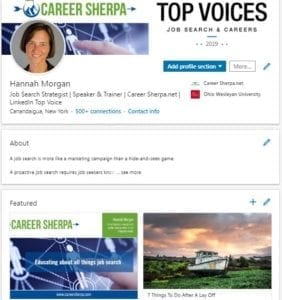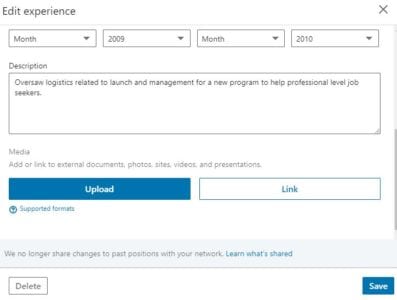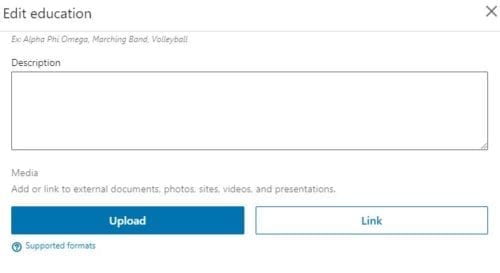Your LinkedIn profile is more than just a boring online resume (or one big blob of text). Isn’t time you start treating it like an online portfolio? Learn how to make your LinkedIn profile media rich!
[Updated October 20, 2020]
Company websites and commercials contain customer testimonials, product demonstrations, and visual proof of their products.
You can too! It just takes a little creativity- ok maybe more than just a little, but you can do it!
Your challenge is to think like a marketer! Think about ways you can use video, presentations and images to convey your message.
What Media Can You Add?
LinkedIn says it officially supports images, video, audio, presentations and documents by certain providers listed here.
The following file formats are supported:
- Adobe PDF (.pdf)
- Microsoft PowerPoint (.ppt/.pps/.pptx/.ppsx/.pot/.potx)
- Microsoft Word (.doc/.docx/.rtf)
- .jpg/.jpeg
- .png
- .gif – this doesn’t support animation, however the first frame will be extracted
Important:
- The file size may not exceed 100 MB.
- The page limit is 300 with a 1 million word count limit
- The maximum resolution for images in 120 mega pixels.
Where Can You Add Media?
Featured section: LinkedIn added a new section to your profile called “Featured.” It appears immediately below your About section.
Previously, you could embed media in your About/Summary section, but now, you would use “Featured” section. Learn more about what you can pin/post to your featured section here.
Under a job: In your experience section, under each job you can embed media (files, video, images, links) to showcase samples of your work, awards and more.
Education: You can embed media or a link under your education. You could include photos, documents, or a link to show your skills. Remember to stay professional and include media that helps elevate you professionally.
Projects: While you can link to an outside source, there is no visual, but it’s still a link.
If you worked on a project (either associated with work or outside of work) you can link to a website article where someone can go to learn more about the project.
Publications: As with projects, you can link to another source to show a published paper or article. No thumbnail is shown, but there is a prominent link.
How To Add Media
To add media or links to your LinkedIn profile, LinkedIn says:
To add or link media samples to your profile:
- Click the Me icon at the top of your LinkedIn homepage.
- Select View profile from the dropdown.
- Click the Edit to the right of [the section you want to add to].
- Under Media, click one of the following options:
- Upload – To add a media sample from your computer. Select your sample and click Open to upload it to LinkedIn.
- Link – To link to an online media sample. Enter your media link into the Paste or type a link to a file or video, and click Add. Note: You can also link to a website.
- In the pop-up window that appears, edit the Title and Description as needed.
Yes, you can use a link to a webpage or uploaded file- both work!
What to Showcase
What would you want someone to find if they were searching for you on the web?
And what differentiates you from the hundreds and thousands of other people who have the same job title as you?
Think about what you can show to prove you know how to do your job.
- Is there a picture of you receiving an award?
- Have you given a presentation or spoken at a conference?
- Have you written articles?
Think of your LinkedIn profile as a brag book and please, begin collecting screenshots and links today.
I’ve Got Nothing
If you don’t have anything, create it!
You can create a PowerPoint highlighting your accomplishments and publish it to SlideShare and share to LinkedIn. See ideas here.
Create mockups or convert data into an infographic or visual.
Grab These Ideas
Letters of recommendation: You have probably received letters of recommendation or testimonials from past customers. Why not create a presentation featuring these quotes? Just be sure to ask permission to use the quotes or testimonials from the people who have written them. And by the way, this is a great opportunity to re-establish your connection with these people.
Work samples: You may have created reports, work instructions, workflow diagrams and other content as an output of projects you worked on. While you may not be able to use the actual documents, you could create a mock-up to share. Upload your work samples under the job in your experience section.
Video: Everyone may not be comfortable in front of a camera, but the video doesn’t have to be your face. It could be a “how to” video. For example, you could create a video on how to create pivot tables, or how to create project plans, or how to organize your email. Use screencasting tools to record your demonstration and upload it to YouTube. Just remember to keep it short. Most ads run under three minutes.
Other video ideas might include showcasing photos or images. Animoto.com can turn these into a 30-second video and publish it to the Web for free.
Hannah Morgan aka Career Sherpa
Or you could create a kinetic animation video like this using CareerBrandVideosTM
Be Creative. The resume is not the only way to demonstrate what you’ve done. Today, there are many more options to publish content and create a robust, interactive representation of who you are.
LinkedIn has become the go-to source for employers seeking new talent. Make sure they find more than just a boring profile.

Hannah Morgan speaks and writes about job search and career strategies. She founded CareerSherpa.net to educate professionals on how to maneuver through today’s job search process. Hannah was nominated as a LinkedIn Top Voice in Job Search and Careers and is a regular contributor to US News & World Report. She has been quoted by media outlets, including Forbes, USA Today, Money Magazine, Huffington Post, as well as many other publications. She is also author of The Infographic Resume and co-author of Social Networking for Business Success.




